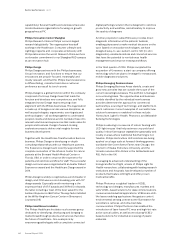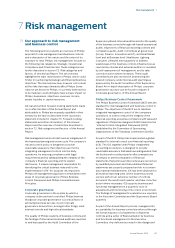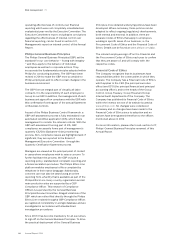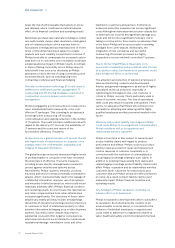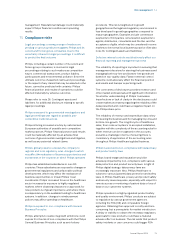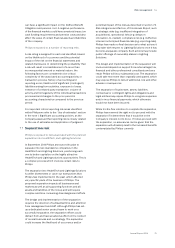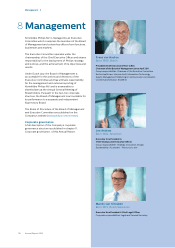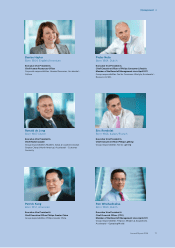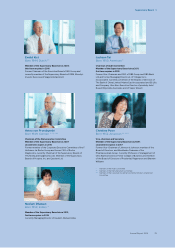Philips 2014 Annual Report Download - page 72
Download and view the complete annual report
Please find page 72 of the 2014 Philips annual report below. You can navigate through the pages in the report by either clicking on the pages listed below, or by using the keyword search tool below to find specific information within the annual report.Risk management 7.4
72 Annual Report 2014
bears the risk of unforeseeable uctuations in prices
and demand, which could have a material adverse
eect on its nancial condition and operating results.
Businesses purchase raw materials including so-called
rare earth metals, copper, steel, aluminum, noble gases
and oil-related products, which exposes them to
uctuations in energy and raw material prices. In recent
times, commodities have been subject to volatile
markets, and such volatility is expected to continue. If
Philips is not able to compensate for increased costs or
pass them on to customers, price increases could have
a material adverse impact on Philips’ results. In contrast,
in times of falling commodity prices, Philips may not
fully benet from such price decreases as Philips
attempts to reduce the risk of rising commodity prices
by several means, such as including long-term
contracting or physical and nancial hedging.
Diversity in information technology (IT) could result in
ineective or inecient business management. IT
outsourcing and o-shoring strategies could result in
complexities in service delivery and contract
management.
Philips is engaged in a continuous drive to create a more
open, standardized and consequently, more cost-
eective IT landscape. This is leading to an approach
involving further outsourcing, o-shoring,
commoditization and ongoing reduction in the number
of IT systems. This could introduce additional risk with
regard to the delivery of IT services, the availability of
IT systems and the scope and nature of the
functionality oered by IT systems.
Philips observes a global increase in IT security threats
and higher levels of sophistication in computer crime,
posing a risk to the condentiality, availability and
integrity of data and information.
The global increase in security threats and higher levels
of professionalism in computer crime have increased
the importance of eective IT security measures,
including proper identity management processes to
protect against unauthorized systems access.
Nevertheless, Philips’ systems, networks, products,
solutions and services remain potentially vulnerable to
attacks, which could potentially lead to the leakage of
condential information, improper use of its systems
and networks or defective products, which could in turn
materially adversely aect Philips’ nancial condition
and operating results. In recent years, the risks that we
and other companies face from cyber-attacks have
increased signicantly. The objectives of these cyber-
attacks vary widely and may include, among things,
disruptions of operations including provision of services
to customers or theft of intellectual property or other
sensitive information belonging to us or other business
partners. Successful cyber-attacks may result in
substantial costs and other negative consequences,
which may include, but are not limited to, lost revenues,
reputational damage, remediation costs, and other
liabilities to customers and partners. Furthermore,
enhanced protection measures can involve signicant
costs. Although we have experienced cyber-attacks but
to date have not incurred any signicant damage as a
result and did not incur signicant monetary cost in
taking corrective action, there can be no assurance that
in the future Philips will be as successful in avoiding
damages from cyber-attacks. Additionally, the
integration of new companies and successful
outsourcing of business processes are highly
dependent on secure and well controlled IT systems.
Due to the fact that Philips is dependent on its
personnel for leadership and specialized skills, the loss
of its ability to attract and retain such personnel would
have an adverse eect on its business.
The attraction and retention of talented employees in
sales and marketing, research and development,
nance and general management, as well as of highly
specialized technical personnel, especially in
transferring technologies to low-cost countries, is
critical to Philips’ success. This is particularly valid in
times of economic recovery. The loss of specialized
skills could also result in business interruptions. There
can be no assurance that Philips will continue to be
successful in attracting and retaining all the highly
qualied employees and key personnel needed in the
future.
Warranty and product liability claims against Philips
could cause Philips to incur signicant costs and aect
Philips’ results as well as its reputation and
relationships with key customers.
Philips is from time to time subject to warranty and
product liability claims with regard to product
performance and eects. Philips could incur product
liability losses as a result of repair and replacement
costs in response to customer complaints or in
connection with the resolution of contemplated or
actual legal proceedings relating to such claims. In
addition to potential losses arising from claims and
related legal proceedings, product liability claims could
aect Philips’ reputation and its relationships with key
customers (both customers for end products and
customers that use Philips’ products in their production
process). As a result, product liability claims could
materially impact Philips’ nancial condition and
operating results.
Any damage to Philips’ reputation could have an
adverse eect on its businesses.
Philips is exposed to developments which could aect
its reputation. Such developments could be of an
environmental or social nature, or connected to the
behavior of individual employees or suppliers and
could relate to adherence to regulations related to
labor, health and safety, environmental and chemical




